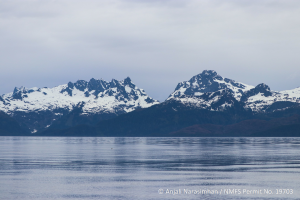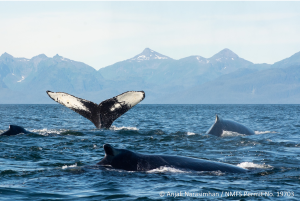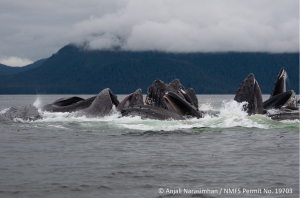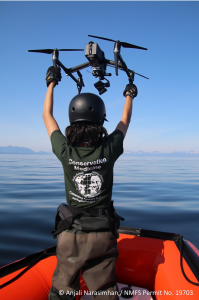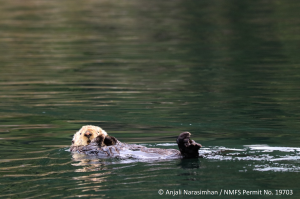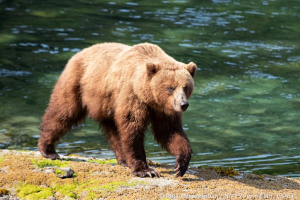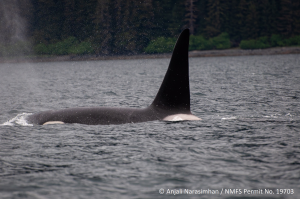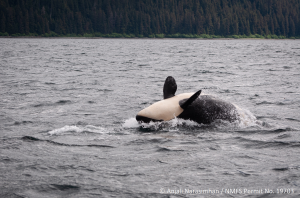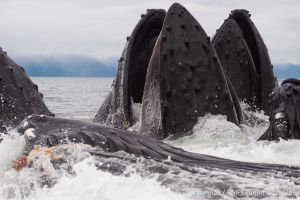-
About
- Leadership & Faculty
- News & Events
-
Academics
- Graduate
- Advanced Clinical Training
- Continuing Education
-
Student Life
-
Research
-
Hospitals & Clinics
- Emergency Care
- Hospital Services
-
Community Outreach
- Volunteer
Anjali Narasimhan, MCM’19 Summer Externship with the Alaska Whale Foundation
"Whales are among the largest and most intelligent species to inhabit this earth. I have always been drawn to these enigmatic creatures and stunned by their unparalleled beauty."
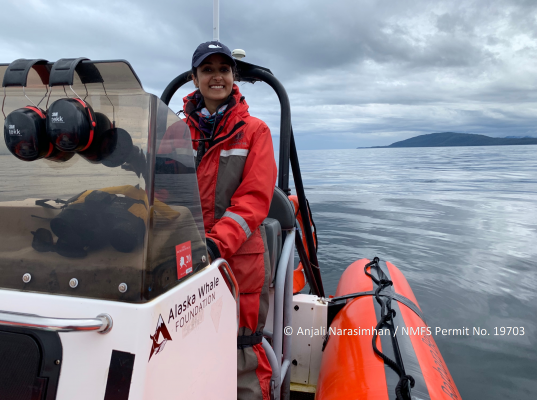
Whales are among the largest and most intelligent species to inhabit this earth. I have always been drawn to these enigmatic creatures and stunned by their unparalleled beauty. Driven to promote ocean conservation and pursue a career in advancing marine mammal health, I sought out a position with the Alaska Whale Foundation and had the exceptional opportunity to study humpback whales in the remote wilderness of Southeast Alaska.
Humpback whales
The commercial whaling of the nineteenth century had a devastating impact on the world’s whales. After its moratorium in 1985, populations have begun to rebound. The humpback whale has had a remarkable recovery and is now gradually increasing throughout its global range. However, whales continue to face threats from vessel-strikes, harassment, underwater noise, entanglement in fishing gear and marine debris, habitat deterioration, and declining prey availability.
Humpback whales are a migratory species. The North Pacific humpback population primarily travel to spend winter at their breeding grounds in Hawaii and Mexico, and return to their foraging grounds in Alaska for the summer. Humpbacks are baleen whales, ranging from 12 – 16 meters in length and weighing over 30 tons. This whale has distinctive features including its humped dorsal fin and long wing-shaped pectoral fins. In addition, their tail flukes have a pattern, shape, and trailing edge that are as unique to each individual whale as fingerprints are to us. The fluke therefore acts as a billboard to advertise the identity of the individual, which can then be photographed, matched, and recorded in whale identification catalogs. Humpbacks are known to vocalize a characteristic song consisting of long squeaks and moans that can travel hundreds of miles and be detected through the use of a hydrophone. Humpbacks primarily filter-feed on krill, a small crustacean, and juvenile fish such as herring or salmon. To aid in feeding, they employ several tools to disorient and herd their prey, including vocalizations, pectoral fins, and bubbles.
A small subset of the Southeastern Alaskan population has developed an ingenious hunting behavior known as bubble-net feeding. This foraging method is complex and coordinated involving groups of distinct individuals each with a designated role. The group dives together and circles beneath their target, vocalizing to disorient their prey and blowing a wall of bubbles in a spiral to trap and form a concentrated prey ball. As soon as the prey is in place, the whales’ surface and begin a lunge feeding frenzy. The whales then dive and the cycle repeats.
Research
The Alaska Whale Foundation is actively supporting a diverse set of research projects. During my externship I assisted with the following:
(1) Cooperative bubble-net foraging surveys with Dr. Andy Dzabo, Alaska Whale Foundation Director, documenting behaviour and vocalizations, as well as photographing flukes to identify present individuals. (2) Bioenergetics study with Ph.D. student Martin Van Aswegen from the Marine Mammal Research Program at the University of Hawaii, using aerial photographs taken by unmanned aerial vehicles (drones) to determine body condition and quantify the bioenergetic demands of migrating individuals. (3) Health indices study with Ph.D. student Kelly Cates from the College of Fisheries and Ocean Science at the University of Alaska Fairbanks, using biopsy and blow samples to determine levels of steroid hormones and thus the stress and reproductive condition of the individual.
A day in the life of a whale researcher
Waking up in the wee hours of the morning to the musical melodies of songbirds chirping away and the boisterous barks and grunts of sea lions in the distance, I crawled out of my cozy sleeping bag and exited the tent into the brisk Alaskan air. The sun never really sleeps here, and neither does the wildlife. This was one of the great pleasures of sleeping outside on top of the roof of the boat.
After a hefty breakfast of oatmeal, the team mobilized. As designated photographer, I geared up in my mustang suit for the day out on the water in the zodiac. Traveling with a research vessel on either side of Chatham Strait we headed towards the Gulf of Alaska in search of bubble-netters. Using a transect survey system, we stopped at each marked point for a timed 15 minutes, scanned for whale blows with binoculars, and dropped the hydrophone to listen for vocalizations. This is repeated throughout the entire day until a target group of bubble-netters is detected. Although seemingly monotonous, these surveys were quite the opposite as we were always surrounded by the picturesque snowy top mountains, passing by groups of floating sea otters, spotting brown bears scavenging in intertidal zones, and frequently visited by playful bow riding Dall’s porpoises zig zagging around the boat.
Having not had any luck finding bubble-netting humpbacks we moved onto our next survey point, which was located within an isolated inlet… and that’s when we encountered a pod of orcas or killer whales. The male’s prominent dorsal fin stood tall above the water, and subadults could be seen in the distance heading our way. We shut off the engine and waited. Camera at the ready, I was prepared to capture shots of their dorsal fins and saddle patches for identification. The subadults began spy hopping around our zodiac, whistling and clicking playfully. I was elated and let out squeals of pure and utter joy. To add to our excitement, a mom and calf carrying a peachy-orange shade of a newborn joined in the fun by leaping out of the water and fin slapping. I will never forget the moment I locked eyes with them as they lingered under the zodiac. It is one thing to observe these magnificent creatures from afar, but it was unreal to have them choose to socially interact and directly observe us.
The killer whale identification photographs were complete, so we began traveling to our next survey point when we received a radio call from the other research vessel affirming bubble-netters. As we jetted off to their location, I could feel my heart pounding with excitement. The waters were still with no sign of them. However, the abundance of seabirds circling and squawking above, and the distinctively pungent fish smells from lingering whale blow indicated their presence. Large bubbles in a circle formation began to appear at the surface, this could only mean one thing… bubble-netters! All of a sudden, the waters were teeming with whales, dramatically bursting through the surface, lunging in every direction, with herring flying through the air. Nothing compares to the majesty of humpback whales. With all this fast-moving whale action, I was frantically shooting images to capture the flukes of each individual, working with Martin to pair my images to his drone flights. In addition, the dorsal fin of each individual must be photographed and matched to each fluke, which is no easy task with active groups of over 20 individuals. Once the images have been captured, Kelly moves in to obtain tissue biopsy samples using a cross bow and a specially designed dart that penetrates the skin, collects a few centimeters of blubber, and bounces back out. We spend hours working to document and collect data from these bubble-netting groups. Sitting out on the water surrounded by humpbacks is incredibly humbling, and fuels me with infinite curiosity, awe, and affection for these magnificent creatures. It is truly a privilege and an honour to encounter and study these gentle giants.
My time in Alaska has been extraordinary. The natural world never fails to continue to fascinate and surprise me at every turn. As I resume my route to becoming a wildlife veterinarian, I will take all these unforgettable adventures with me and continue to work towards protecting the incredible biodiversity that fills our blue planet.
All photographs were obtained during research sampling with the Alaska Whale Foundation under NMFS Permit No. 19703
